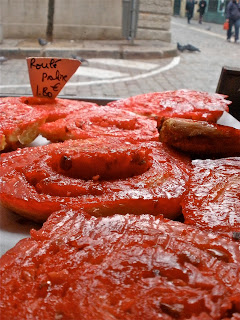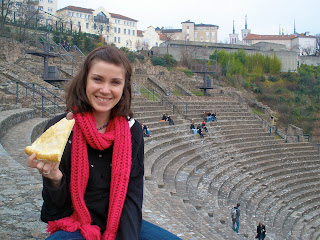So last weekend (right after John left) I went to visit one of my colleague’s daughter, Sarah, who studies in Lyon in the Rhône-Alps region of France. I met Sarah way back in October when she showed me around Toulouse and made me a list (that I still have) of must-see/eat/read/enjoy things in France. She rocks.
 |
| View of Lyon from the basilica Fourvière |
I left Toulouse Thursday evening after my classes and arrived with no difficulty, 4 and a half hours later, in Lyon (a little less than halfway North of here to Paris, further East near Northern Italy and Switzerland). Just to brief you, Lyon is known for many things, most notably: silk production, Guignol the puppet, gastronomy, and being the birth place of the Freres Lumiere who are attributed with "inventing cinema."
As Sarah had classes Friday during the day, she lent me her Guide Routard, various maps, and some great suggestions of things to occupy myself with. I got a bit of a late start as I caught up on some much needed sleep. Around 11 I started out on foot from Sarah’s place, crossed over the Rhône river to get to the Presqu’isle, or Almost Island, which is the downtown area of Lyon, called such because the Rhone and the Soane rivers almost touch at the Northern part of this district, almost forming an Island. On my way I got snagged by a store, as it was the end of the nationalized sales in France (70% off!!), I had to make sure I wasn’t missing out on a deal. Exhausted from my 15 minute walk and power-shopping pit stop, I broke for lunch at the first destination on my list: Place Bellecour.
While perusing my guide and munching a pumpkin chestnut sandwich (MMM!), I started talking to a gentleman who turned out to be from Mexico, have family in San Francisco, and live in Lyon. He was a photographer completely enamored with France and especially Lyon. A bit of an artist, he started to raptly tell me some of the history and his favorite elements of the city. There’s an element of duality to Lyon, he explained, and I agreed with, as on the one hand it’s very bourgeoisie definitely one the wealthiest cities I’ve seen in France, with palpable, lingering royalist sentiments, yet you also have this history of communism and resistance toward equality and the common good from the French Revolution and also the other revolts that played out in Lyon (of which I found more about later).
“You’re only here for the weekend??!?” He asked alarmed at the end of his digression of Lyon's schizophrenia. “What are you doing talking to me?”, as he continued to talk my ear off. “You have to get out and see the city! This neighborhood alone will take you the whole afternoon!” And, “What? You’re staying with a twenty something? They know nothing about the city!”
“Au contraire.” I said defensively and showed him my guidebook, maps, and handwritten notes at him. The fire lighted, I set off from the Place Bellecour toward the neighborhood known as Croix-Rousse, that is elvated 250 meters over the city.
 |
| I guess it's okay to double park in the middle of a round-about when your car is the size of a trunk. The Croix-Rousse neighborhood definitely embodies the aforementioned second identity of Lyon, that of revolt, and inssurection. It was there that the canuts, or silk workers of Lyon, were concentrated (read: exiled) in the 19th century. The the canuts, and thus the neighborhood have a fascinating history. The workers revolted in 1831 and again in 1834, descending into the city of Lyon and overtaking various buildings in the name of improving their inhumane work conditions. Those were known as some of the first revolutions in France in the name of laborers. In 1848 and 49, influenced by the great social movements of the time, the canuts revolted again, this time in an effort to form a community of interests, or a Marxist-influenced commune of sorts. While in Croix-Rousee I visited the Cour des Voraces, a very symbolic building, designed and constructed by the silk workers that today represents revolt and reisistance in Lyonnais history. You enter the Cour from the street by a wooden door that looks just like the others on either side of it. You find yourself at the top of very large stone steps that descend down under ground. Ahead of you is open, as if someone cut the building in half and you can see all the floods, and there is a stairway traversing them. There is a plaque that reads that in this Cours de Voraces, the silk workers, the canuts, foughts for their standards of living and their dignity. This place served as a refuge for the canuts during the second wave of revolts in 1848 and 49. |
 |
| Three of the 15 colored bobbins that contributed to this particular fabric |
While kickin in it Croix-Rousse I visited La Maison des Canuts, where I attended a silk workshop where I learned all about how silk is produced from cocoon to spool, the difference between velour, brocade, and embroidery, and also watched a demonstration on a loom. Lyon is still one of the largest silk productors in Europe, with 2 of the 3 main manufacturers based Lyon and the third in Milan. I leaned that for a piece of fabric with 15 colors, like the one the woman demonstrated to us, it takes 8 hours to produce 20 centimenters. Louis XVIII, after a visit to Lyon, apparently ordered 70,000 meters of fabric even more elaborate than this one for he an his wife to be outfitted in. Snazzy.
 |
| View of Place des Terraux from the courtyard of the Musée des Beaux Arts |
Armed with the savoir-fair I had acquired from my silk workshop Friday, I was ready to enter the Musée de Tissue, or Fabric Museum on Saturday with Sarah. This museum traces the history of different fabrics throughout the world, as well as traces the history of silk in Lyon and the fashions of the courts through the ages. OK so you might be thinking, who cares about valorized velours and hyped hemlines (alliteration!), but it's cool to be in a city that had enough money to be relevant during Napoleon, unlike other places I've lived like Rennes and Toulouse that were still farmland at that time. We always think that Europe is old in relation to the US, which is it, but not all places here have the same level and richness of history.
A girl after my own heart, Sarah knew her gastronomie, most importantly, her pastries. She took to me to an incredibly popular boulangerie to get some goodies for lunch.
 |
| We got there just before the line! |
 |
| Lyon is known for its praline confections |
We picnicked at an ancient Roman amphitheater in the Fourvière neighborhood on the left side of the river which you have to take a cable car to access (or climb a ton of steep stairs), that has a great view of the city. Thanks to the Guide Routard, which I had my nose buried in half the time, I learned that Lyon was founded between the two rivers, under the name Lugdunum, by the Gauls in 43 BC, and that the origin of the via domitia, or one of the ancient roman roads that runs through Narbonne which I visited with John.
After lunch we descended Fourvière, and walked around Vieux-Lyon, or the Old Part of the city that was constructed in the first century AD. The architecture of the solid stone buildings was gorgeous. We wanted around the cobblestone pedestrian streets, waiting for people to come out of the private residences so that we could wedge a foot in the door and see the unique entrance halls of these buildings. They are one of the only examples of traboules or secret staircases and passageways that connect one street to another that were used during the French Revolution and the revolts of the canuts. You enter the old wooden doors, and sometimes you find yourself in a low tunnel, sometimes you descend immediately old worn stone steps into a dungeon like maze of passageways, and sometimes you find yourself in a bright sunny courtyards, with turrets of spiral staircases rising up around you. It felt like I was on a treasure hunt, so cool!
 |
| Tour Rose in Old Lyon |
Besides all the sightseeing Sarah and I ate out once, cooked at her apartment, and hung out with her friends. It was truly a spectacular weekend. A huge MERCI to Sarah for showing me around and making sure I got the absolute most out of 3 days in Lyon!
I didn’t eat my praline brioche until the train on the way home Sunday morning, which while initially upsetting was probably a good thing as if I had know about them sooner, I would have consumed at least a dozen. Seriously.
Until the next adventure. Bisous!
Linz



Great summary! It was a pleasure to have you as a guest!
ReplyDeleteOh la la en anglais en plus ;) J'ai omit notre aventure de velo'v, ça reste entre nous!
ReplyDelete